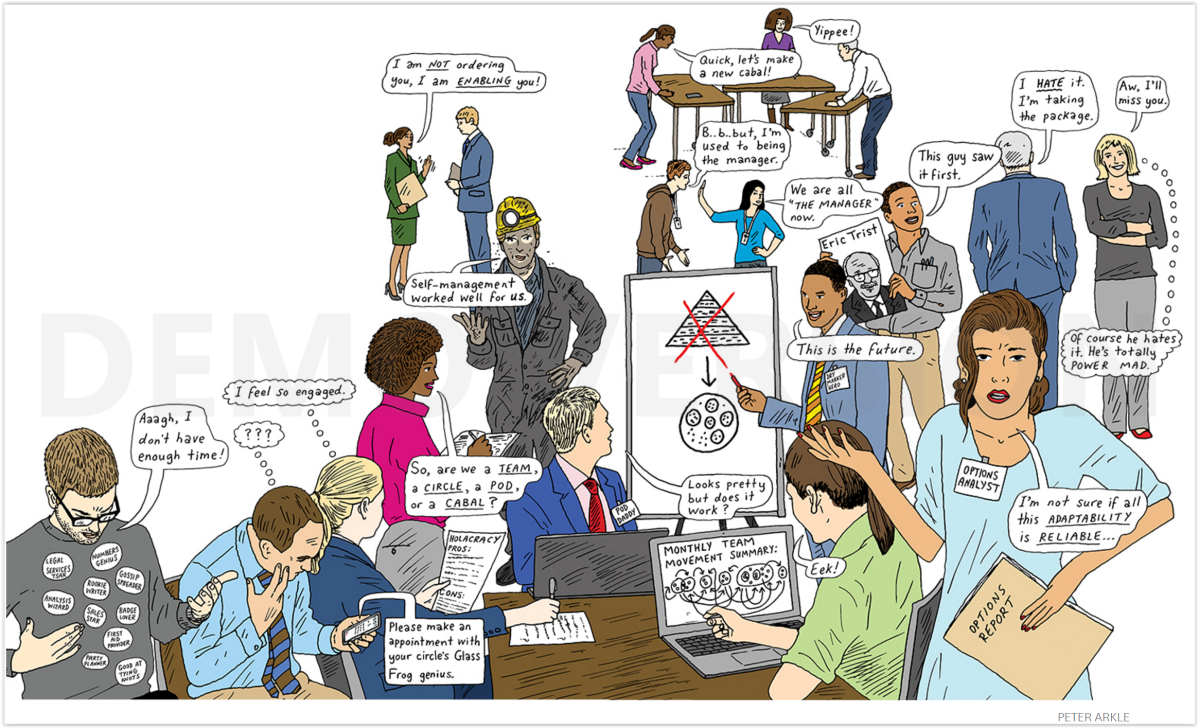In the Harvard Business Review article Beyond the holacracy hype, Ethan Bernstein, John Bunch, Niko Canner and Michael Lee, try “to gain a more accurate, balanced perspective” about holacracy and other types of self-managed organizations [-] beyond the buzzwords that describe these structures—“postbureaucratic,” “poststructuralist,” “information-based,” “organic,” and so on”. On twitter and other social media, these self-managed organisations are heavily supported or attacked. This article tries to be more objective and puts pro’s and con’s against each other.
Again I highlight some quotes that summarises their findings.
Two extremes
Most observers who have written about holacracy and other types of self-managed organizations—the latest trend in self-managed teams—take an extreme position, either celebrating these “bossless,” “flat” environments for fostering flexibility and engagement or denouncing them as naive social experiments that ignore how things really get done.
Balance between reliability and adaptability
To better understand the impulse behind self-management models, consider what leaders need most from their organizations: reliability and adaptability. Reliability means many things, such as generating predictable returns for shareholders, adhering to regulations, maintaining stable employment levels, and fulfilling customers’ expectations. So does adaptability: For example, some situations call for many small adjustments in production or manufacturing to meet local needs, while others call for fundamental shifts in strategy or capabilities.
If traditional organizations strive to be machines governed by Newtonian physics, precisely predicting and controlling the paths of individual particles, then self-managing structures are akin to biological organisms, with their rapid proliferation and evolution.
Teams
The modularity allows for more plug-and-play activity across the enterprise than in a system where teams sit squarely in particular units and departments. And the teams come and go as employees perceive changes in the organization’s needs (just as task forces and project teams in traditional organizations do, but without the surrounding matrix structure, which has a way of holding ad hoc groups together even after they’re irrelevant).
So the circles [teams] don’t just manage themselves; within those guidelines, they also design and govern themselves.
Roles
Leadership responsibilities continually shift as the work changes and as teams create and define new roles.
When someone isn’t a good fit for a role, it’s reassigned to someone else.
This approach to role design gives people room to grow on the job.
Complexity
“Is the shift from traditional jobs to a larger number of microroles a net benefit? Possibly—but role proliferation has costs, too. It creates three kinds of complexity, all related to human capital”
- People grapple with where to focus their attention and how to prioritize and coordinate across circles.
- As people assemble their personal portfolios of roles, it becomes difficult to find clear benchmarks or market rates.
- Role proliferation complicates hiring, both into the organization and into particular roles.
Old power rules
Rather than run ideas up the flagpole and wait for answers to come back down, individuals go directly to the people who will be affected. Within holacracies, this is known as “going role to role.”
Some people have more power than others, and managers who used to supervise certain activities may at times try to reassert control, making it hard for employees to know whether to follow the new system or listen to their old boss.
It can also be tough for people to “step up” and claim their power.
Another employee, who formerly had a managerial title, talked about how much time he used to spend approving others’ decisions. Since the move to holacracy, he’s had to shift to enabling mode, encouraging individuals to make decisions on their own.
Old power rules can be deeply embedded in culture and institutions and may require continual attention to unravel.
Yet a great deal of evidence shows that efforts to drive change programmatically from the top, solely in response to what senior leaders see, often fail.
Responding to emerging needs in the market
Although it’s important to be close to your customers, it’s also critical to maintain a broader perspective so that you don’t follow them off a cliff.
Get rid of all bosses?
You might assume that the three goals of self-management structures—designing roles that match individual capabilities with organizational goals, making decisions closer to the work, and responding to emerging market needs—would make leaders less relevant. Yet one of the greatest challenges of implementing the goals at scale is insufficient leadership.
Leadership might be even more important in a holacracy than in a traditional management structure. You have to lead by example and round up the troops rather than rely on authority.”
Conclusion
Most organizations, particularly large corporations, should adopt these techniques in part, not in whole. We’d be surprised if more than 20% of the Global 1000 looked “teal” in 2030, to use Frederic Laloux’s term for “whole,” evolutionary, self-managing organizations. But we’d also be surprised if more than 20% didn’t significantly draw on some of the techniques within their corporate frameworks.


